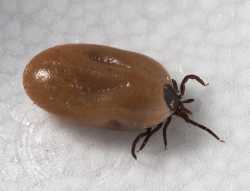17 Jan Lyme Disease Ticks Common in Eastern US National Parks
MedicalResearch.com Interview with:
Tammi L. Johnson PhD, Microbiologist
Division of Vector-Borne Diseases
CDC
MedicalResearch.com: What is the background for this study?
Response: Lyme disease is caused by the bacterium Borrelia burgdorferi and is transmitted to humans through the bite of infected blacklegged ticks, also called deer ticks. Lyme disease is the most commonly reported vectorborne illness in the United States, with approximately 300,000 humans becoming infected each year.
While Lyme disease infections are highly concentrated in the northeast and upper Midwest, the number of counties in which the blacklegged tick has become “established” has more than doubled in the past two decades. Established populations of these ticks are found in 35 states.
Knowing that Lyme disease is increasing both in numbers of infections and in geographic range in the United States, we did this study to determine if people are at risk of encountering infected ticks while recreating in eastern national parks. This is the first large-scale survey in multiple national parks, and though suspected, it had not been confirmed that ticks in many of these parks were infected.
So the purpose of the study was to survey national park units across six Northeastern and Mid-Atlantic States and the District of Columbia, ranging from Maine in the north to Virginia in the south and characterize the risk of human exposure to ticks-borne bacteria.
Researchers from the Centers for Disease Control and Prevention and the National Park Service evaluated frequently used trails in Acadia National Park, Catoctin Mountain Park, Fire Island National Seashore, Gettysburg National Military Park, Manassas National Battlefield Park, Monocacy National Battlefield, Prince William Forest Park, Rock Creek Park, and Shenandoah National Park.
MedicalResearch.com: What are the main findings?
Response: We collected ticks along hiking trails in seven National Park Units in the eastern United States in May and June in 2014 and from nine National Park Units in the eastern United States between May and August 2015. We found blacklegged ticks infected with the bacteria that causes Lyme disease at all of the parks sampled.
We also documented the presence of blacklegged ticks in two new areas, Greene County, Virginia, and an urban park in the District of Columbia. The parks sampled represent only a small portion of national parks and recreational opportunities in the area. The results of the study likely represent recreational risk in other parks in the eastern United States not sampled.
MedicalResearch.com: What should readers take away from your report?
Response: The results of this study serve as a reminder that, while enjoying the parks, visitors should take steps to help protect themselves and their loved ones from tick bites.
Promoting prevention efforts in these national parks may be particularly important for those visitors traveling from areas where Lyme disease is not common. These visitors may be unfamiliar with ticks, tick bites, and the symptoms of tickborne disease.
Some tick bite prevention tips include:
- Use products that contain permethrin on clothing.
- Shower within two hours of leaving a tick-prone area to wash off ticks that may be crawling on you.
- Check yourself for ticks and remove attached ticks.
- Dry clothes in a dryer on high heat for 10 minutes to kill any ticks on your clothing.
- Check pets and gear for ticks.
- Hike in the center of trails.
- Avoid sitting down or leaning on logs or bushes along the trail.

The blacklegged or deer tick, Ixodes scapularis, transmits Lyme disease, a disease caused by a spiral shaped bacterial microbe, Borrelia burgdorferi. This disease is known from Europe, Africa, Asia, and in almost all the United States. It is especially common in the Northeast, in Minnesota and in northern California. This larval tick is no bigger than the size of the period at the end of this sentence. CDC Image
It’s also important to know that blacklegged ticks need to be attached for at least 24 hours before they can transmit Lyme disease. For this reason, daily full-body tick checks can help you find and remove ticks before they attach or have time to transmit disease.
More information can be found at https://www.cdc.gov/lyme/.
MedicalResearch.com: What recommendations do you have for future research as a result of this study?
Response: Additional studies are needed to evaluate how frequently people encounter ticks in national parks and to identify specific behaviors that may result in increased risk of tick encounter. Future research regarding visitors’ tick bite prevention knowledge, attitudes, and behavior could help to more appropriately target prevention messages.
MedicalResearch.com: Thank you for your contribution to the MedicalResearch.com community.
Citation:
Tammi L. Johnson, Christine B. Graham, Karen A. Boegler, Cara C. Cherry, Sarah E. Maes, Mark A. Pilgard, Andrias Hojgaard, Danielle E. Buttke, Rebecca J. Eisen
DOI: http://dx.doi.org/10.1093/jme/tjw213 tjw213 First published online: 27 December 2016
Note: Content is Not intended as medical advice. Please consult your health care provider regarding your specific medical condition and questions.
More Medical Research Interviews on MedicalResearch.com
[wysija_form id=”5″]
Last Updated on January 17, 2017 by Marie Benz MD FAAD
